‘We came for 15 days… but three years on we STILL live here’: Inside Jordan’s sprawling Zaatari refugee camp – home to 80,000 migrants fleeing war in Syria
- Zaatari refugee camp is a sprawling mass of cabins in the Jordanian desert
- Jordan has welcomed more than a million Syrian refugees since war began
- Families expected to be in Jordan for just days, but are still there years on
- But UNHCR warns the ever more permanent camp isn’t a ‘durable’ solution
- Jordan’s King Abdullah warned that the country was nearing ‘boiling point’
In the deserts of northern Jordan lies the largest Syrian refugee camp in the world – a sprawling mass of cabins, home to 80,000 people.
Syrian father-of-three Mohammad Ramadan told MailOnline how he and his family believed they would only be living in the Zaatari camp for 15 days, waiting for the violence in their home country to blow over.
But as the conflict enters its sixth year the family is still living in a one-room container, which has become even more cramped since the birth of their third child in the camp.

Family: Syrian father-of-three Mohammad Ramadan told MailOnline that he had his family only expected to be in the Zaatari camp for 15 days – but three years later they are still here

Pressure:Lack of work opportunities, strained health and education services and soaring accommodation prices are the most pressing concerns
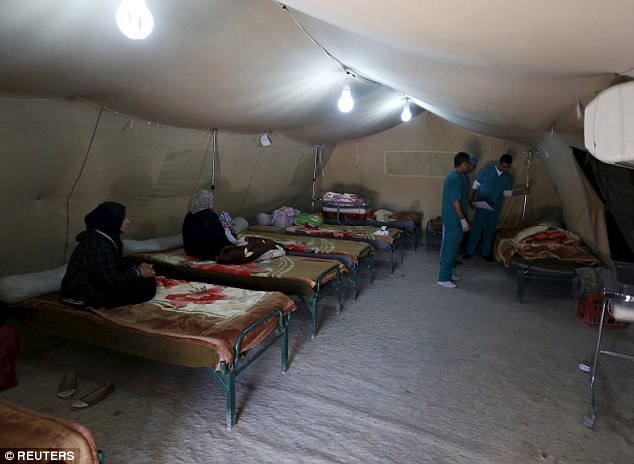
Help: According to officials from the UNHCR, the refugees living in the camp are completely aid-dependent as they are given so few opportunities for work and education
‘Nobody expected this,’ says 30-year-old Mohammad, one of the 4.8million Syrian refugees who have fled the country since 2011, according to the UN.
‘We left with only the clothes on our backs, and a few personal belongings. We thought we would be back in 15 days.’
The family fled their house at dawn one morning in March 2013, arriving in a village close to the Jordanian border at 6am. Twelve hours later when the sun set and the road became safer, they crossed the border.
Had they been caught, they could have been killed. But exhausted, three hours later, they arrived.

Shock: Three years on, the family are still living in the one-room container which has become home

Children: The family sleeps together in a one-room container, which has become even more cramped since the birth of their third child in the camp (file picture)
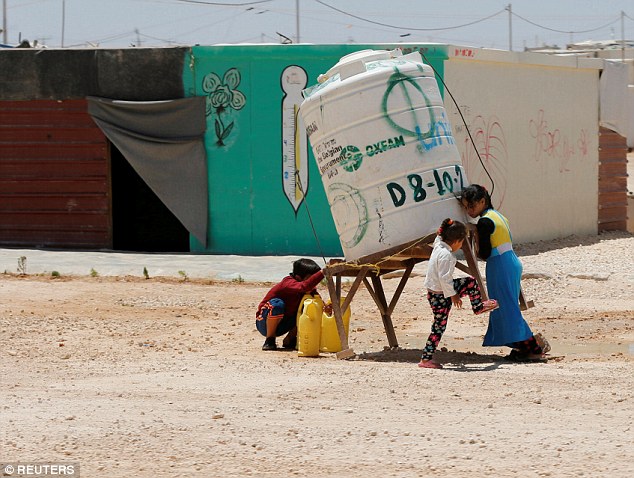
Home: The family’s container is almost entirely taken up by their five thin mattresses, laid out on the floor. Their only other possessions are a battered old TV set and two plastic chests of drawers

War child: An estimated 80 babies are born every week in the Zaatari camp’s maternity wards
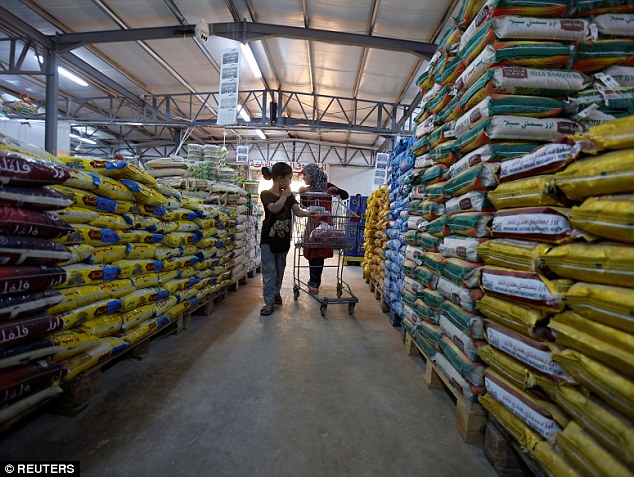
Makeshift: Mohammad and his wife welcomed their third child inside the camp – one of the 80 babies born every week in the camp’s two maternity hospitals
‘The Jordanian army received us. There were about 180 men, women and children with us there. We were taken to a camp, where they gave us water, biscuits and some food.’
But as the days passed it became clear the situation back home remained far too dangerous to return.
Jordan estimates that more than a million Syrian refugees – an estimated 90 per cent of whom living outside of the camps – have flooded into the kingdom, whose total population amounts to just 6.4million.
And tensions are near breaking point as the crisis exacerbates Jordan’s existing economic woes.
Lack of work opportunities, education and accommodation are the most pressing concerns, as in just five years Jordan has spent an estimated £4.5billion on refugees.
‘We can see European countries struggling to deal with waves of asylum seekers,’ said Jordan’s minister of planning and international cooperation, Imad Fakhoury, in October 2015.
‘But in just one or two days, Jordan receives the number of people who have arrived in some European countries in total.’
In a recent interview King Abdullah himself warned that the country was nearing ‘boiling point’, as a quarter of the total state budget is spent on helping refugees.
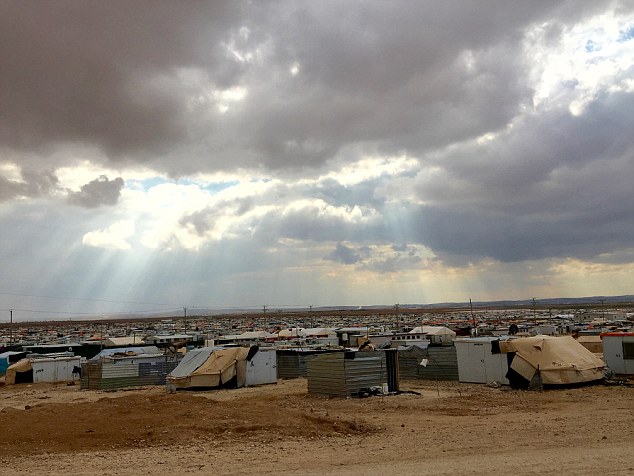
Escape: Mohammad, his wife and children fled their home in March 2013 and travelled to the camp. They expected to stay for a few days while the violence in their home country blew over
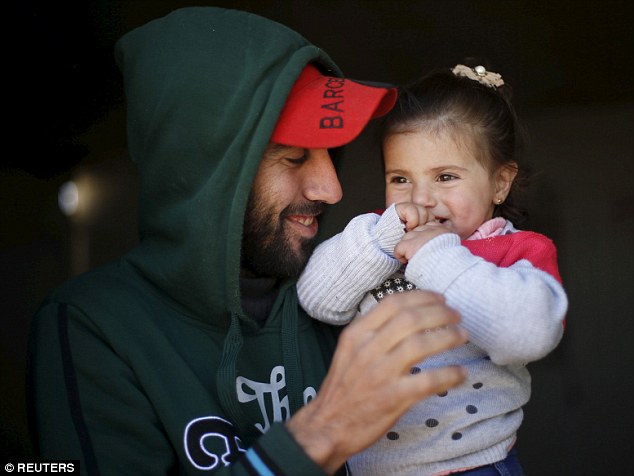
Struggle: The refugee crisis is putting increasing pressure on the country’s already strained economy. It is estimated to have taken in some one million refugees, despite only having an estimated population of 6.4m
‘Sooner or later, I think, the dam is going to burst,’ he said.
Today, Mohammad lives in the cramped, thin-walled container with his wife and children – Yousef, five, Ahmed, three, and Heba, one.
Their one-room cabin contains their few possessions: a bulky old television set and two plastic chests of drawers, atop of which stands a deodorant stick, some hand cream, medicine and a bottle of juice.
All around there was a feeling of insecurity. There were clashes. There was shelling. My kids were so scared. I was afraid too.
Mohammad Ramadan
The family have added some personal touches, decorating surfaces with brightly-coloured cloths and hanging quotes from the Koran on the back wall.
Five foam mattresses covered in fabric lie along the edges of the room, leaving only a narrow gap near the door in order to enter and exit without stepping on someone’s bed.
On the floor, what would have been a thick carpet or cool stone in a Syrian home is here a thread-bare tarpaulin sack with the logo of UNHCR, the UN refugee relief agency, laid out as a makeshift ‘welcome’ mat.
Just over three years ago, Mohammad’s life was very different.
He lived in a five-room house in the Daraa governorate, in south-western Syria, with his parents, wife and two young children.
Though not rich, he made a living as a carpenter, often crossing the border into neighbouring Lebanon to find work as the economic situation in Syria deteriorated.
‘We didn’t see it coming,’ he said. ‘Security was strong. Social issues were okay. The economy was not that good and prices had started to go up.
‘But still, it was all a surprise.’

Work: Entrepreneurial Syrians try to sell water and whatever they can get imported into the camp to sell
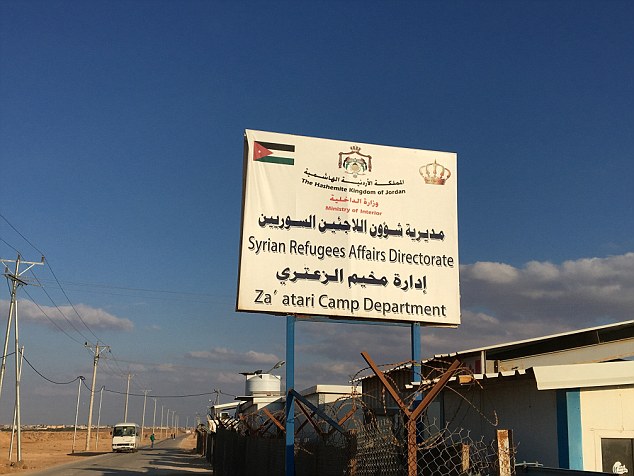
Refuge: Mohammad’s life used to be very different. Before arriving at the Zaatari camp (pictured) he lived in a five-room house in the Daraa governorate, in south-western Syria, with his parents, wife and two children

Safety: After protests spread like wildfire across the country, demanding for Assad to step down, millions of refugees have had to flee to neighbouring countries Jordan, Turkey, Lebanon and Iraq for safety
Daraa’s main city, also called Daraa, was where the fuse for the Syrian revolution was first ignited in March 2011.
‘The people want to topple the regime!’ A graffiti message scrawled on a school wall by 15 local boys aged between 10 and 15 in early 2011.
The boys were seized, beaten and tortured. Their fingernails pulled out by Assad’s henchmen.
Their families and others took to the streets in furious protest, chanting ‘God, Syria, Freedom’ and accusing the Assad family of corruption – only to be met with violence and bullets from the security forces.
Protests spread like wildfire across the country, demanding for Assad to step down.
But Mohammad is cautious in talking about politics for fear of retribution on his relatives back home.
‘There were also many arrests,’ he says simply, describing the political clampdown which followed in the wake of the 2011 protests.

Fight: Child marriage is a serious concern in the camp. Above, some girls have launched an initiative to fight it
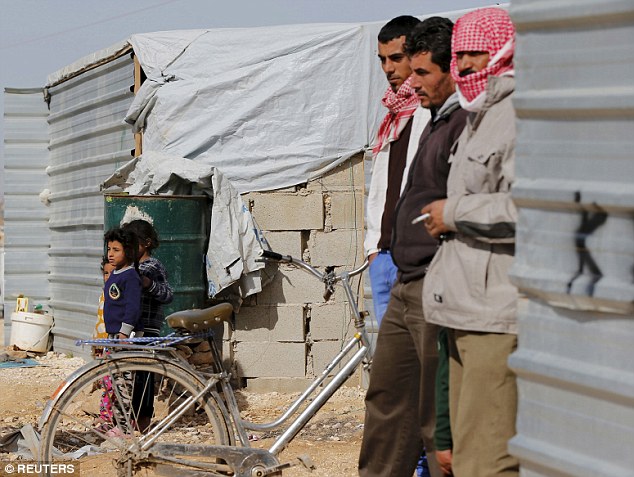
Violence: As the Syrian war enters its sixth year, some 470,000 people have been killed; another 1.9million have been injured; and 6.6million have been displaced
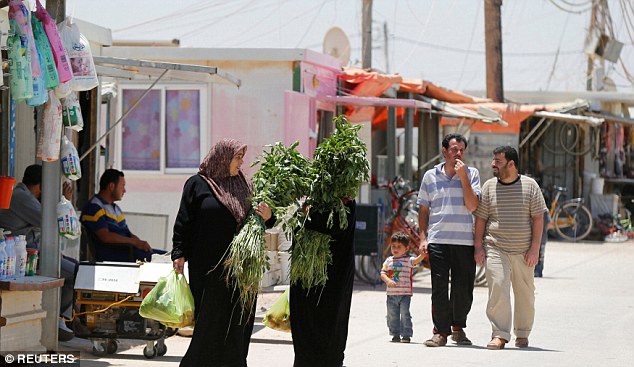
Sudden: For Mohammad, as for many others, the war in Syria came as a surprise. He told MailOnline that no one could have seen the extent of the violence coming
Mohammad kept hoping that things would quieten down. Instead, war broke out and heavy fighting reached Daraa.
‘All around there was a feeling of insecurity,’ he says. ‘There were clashes. There was shelling. My kids were so scared. I was afraid, too, like many others.
‘After that, I saw many people being killed – and that’s when I decided to flee.’
But though Mohammad’s face shows desperation, there are hundreds of thousands of other Syrians who would consider him lucky.
After six years of war, more than 470,000 people have been killed according to the Syrian Centre for Policy Research. Another 1.9million have been injured.
Inside Syria, 6.6million people have been displaced. Some 450,000 live under siege, many of them facing starvation.
Tens of thousands more are currently stranded near the Jordan-Syria border, desperate to be granted access to the nation.
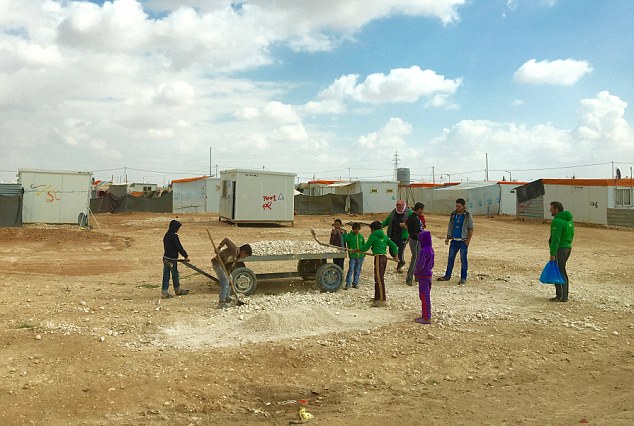
Community: As the war continues, the Zaatari camp – now the fourth largest ‘city’ in Jordan – is becoming ever more permanent, as its streets and infrastructure develop

Temporary home: Each refugee family tries to make their ‘container’ home by adding personal touches
As the Syrian conflict shows no signs of abating, the Zaatari camp has grown from a cluster of tents to a vast network of caravans, complete with street names, schools and hospitals.
In terms of population, it is Jordan’s fourth largest ‘city’ – its map and layout can even be accessed online.
It was here that Mohammad’s youngest daughter Heba was born, one of the up to 80 babies estimated to have been born every week in the camp’s two maternity hospitals.
Her two brothers Yousef and Ahmed attend a local kindergarten and spend hours playing in the dust outside with other children.
Meanwhile Mohammad is struggling to find work to provide for his growing family.
According to Gavin White, of UNHCR, the refugees living in the camp are 100 per cent aid-dependent and many fear that Zaatari will turn into a permanent settlement devoid of any opportunities.
A 2004 UNHCR study estimated that the average duration of a major refugee situation was 17 years.
‘The camp is not a durable solution,’ said Mr White.
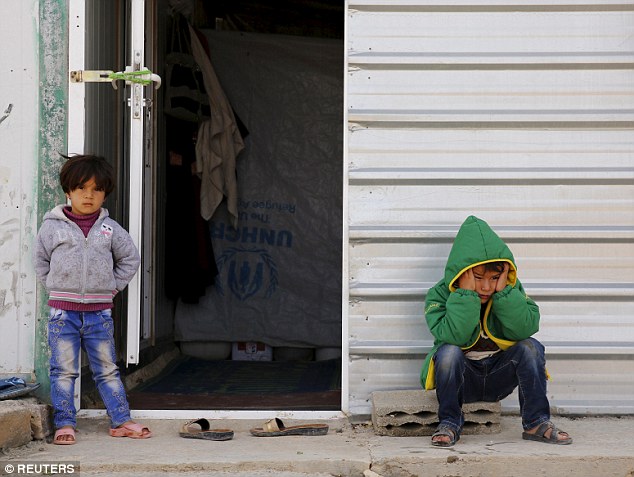
Economy: For Mohammad, as for many other refugees living in the camp, the biggest challenge is to find work, in order to earn money and help support his family
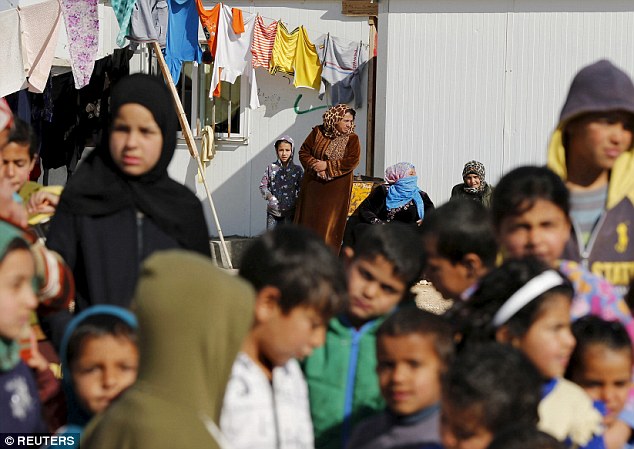
Work: Within the camp, various shops have sprung up, such as this fruit and vegetable stall. But those who run them are dependent on outsiders bringing them produce – as they are only allowed to leave the camp with a special permit
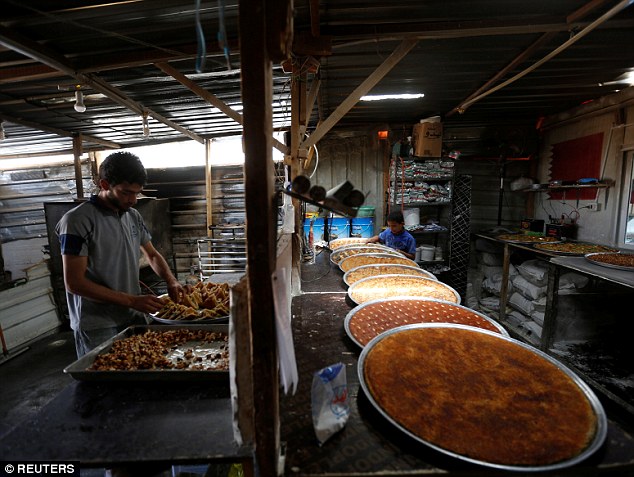
Choices: According to UNHCR officials, the camp is not a ‘durable solution’, as refugees don’t have the same ‘life choices’ as other people making them 100 per cent dependent on aid and NGOs
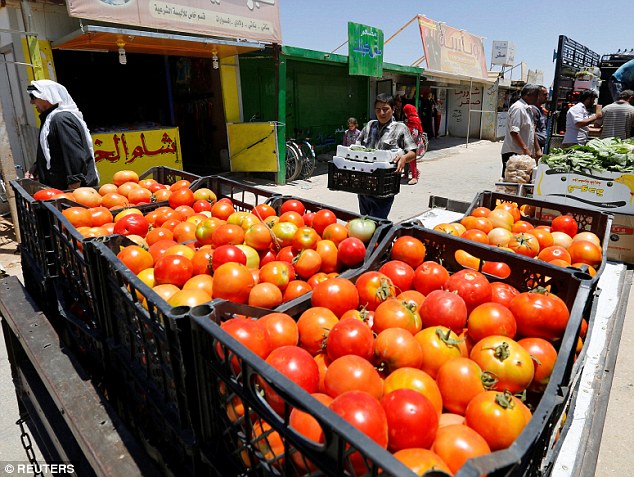
Hope: For Mohammad and his family, the only chance of leaving the camp is if a solution to the conflict back home can be found and they can be reunited with their family and friends
‘You don’t have the same life choices as a refugee. In this context, they don’t have access to labour opportunities. They don’t have opportunities for high-end skills training. High school graduates have limited choices concerning higher education.’
All that remains for Mohammad and his family is to hope for a solution to the conflict back home and be reunited with their family, friends and relatives.
The best political solution, he says wearily, is for everything ‘to go back as it was’.
‘Assad should go but all the rest should stay.’
